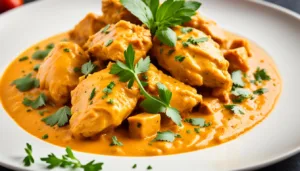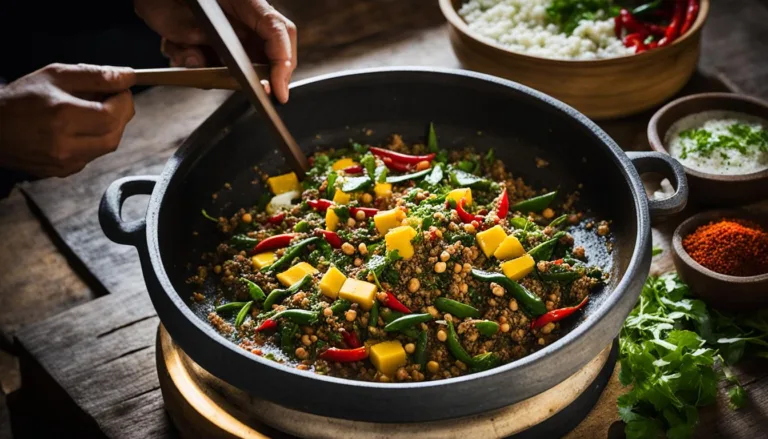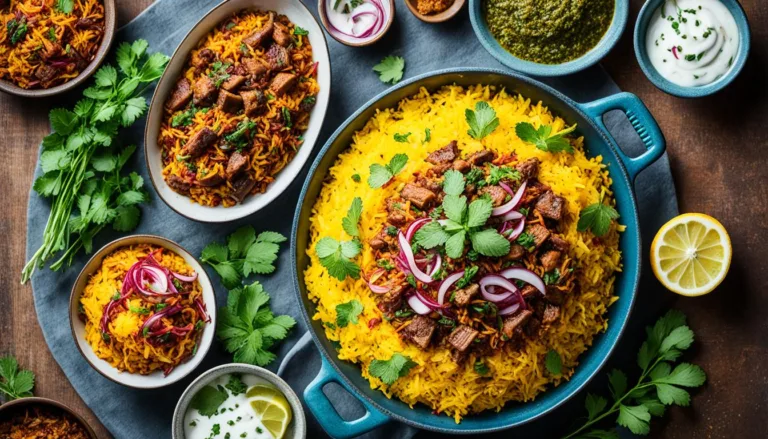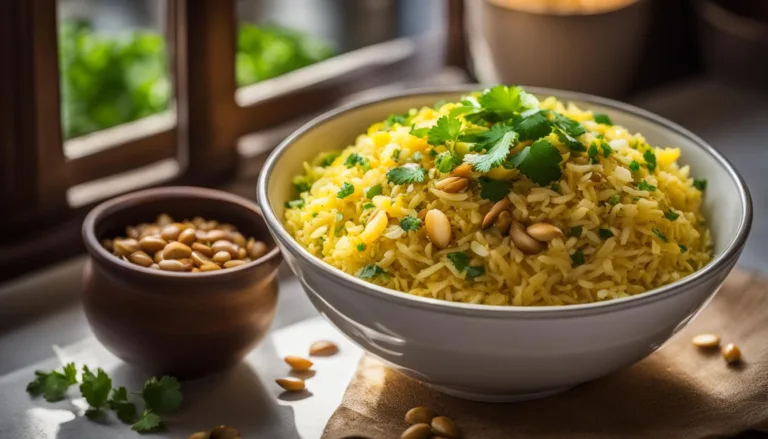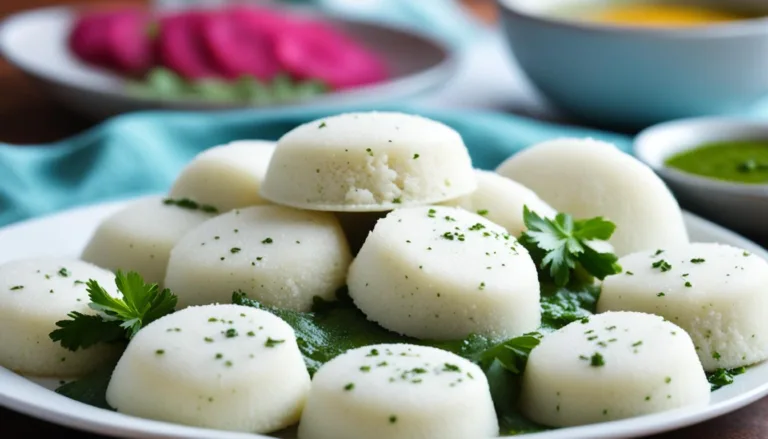Welcome to our article on the delicious Kochu Bata recipe, a Bengali delicacy that will surely add a burst of flavor to your meals. As we explore this easy-to-follow recipe, get ready to embark on a culinary journey that showcases the unique tastes of Bengal. Whether you’re a seasoned cook or a beginner, this side dish recipe is perfect for home cooking.
Kochu Bata is a traditional Bengali dish that holds a special place in Bengali cuisine. It is a monsoon favorite, known for its unique flavors and versatility. Kochu Bata adds a touch of authenticity and spice to any meal, making it a must-try recipe for food enthusiasts.
Special recommendation for Kochu Bata Recipe
- Use Maan Kochu, also known as Malanga Coco or Taro Root, as the main ingredient for Kochu Bata Recipe. Maan Kochu is a seasonal vegetable that adds a distinct flavor and texture to the dish. The process of preparing Kochu Bata involves grating the Maan Kochu and combining it with other spices and ingredients to create a flavorful paste.
- Use raw mustard oil for garnishing at the end


| Variety | Seasonality | Taste |
|---|---|---|
| Sreedevi | Monsoon | Delicate, slightly sweet |
| Prajanma | Monsoon | Robust, earthy |
| Radhika | Monsoon | Distinctive, nutty |
The Traditional Cooking Method for Kochu Bata Recipe
In the preparation of Kochu Bata, tradition plays a significant role. The process of making this Bengali delicacy has evolved over the years, with the introduction of modern kitchenware and cooking techniques. Let us explore the traditional cooking method for Kochu Bata and the transition from using traditional tools like Shil-Nora to contemporary kitchenware.
From Shil-Nora to Modern Kitchenware (Kochu Bata Recipe)
In the past, the primary tool used to make Kochu Bata was the Shil-Nora, a traditional grinding stone made of granite or other sturdy materials. This tool consisted of a flat surface and a cylindrical rolling pin-like object. The Maan Kochu (Taro Root) was manually ground on the stone to create a fine paste.
Today, with the advent of modern kitchenware, home cooks have various appliances at their disposal to simplify the process. Electric blenders and food processors have replaced the labor-intensive grinding process, making it quicker and more convenient to prepare Kochu Bata.
Boiling vs. Pan-Roasting Techniques
When it comes to cooking Kochu Bata, two popular techniques stand out: boiling and pan-roasting. Each method imparts a distinct flavor and texture to the dish.
Boiling Technique:
In the boiling technique, the Maan Kochu is peeled, chopped, and boiled until tender. Once cooked, the taro roots are drained and mashed to create a smooth paste. This method is ideal for a softer and creamier texture in the final dish.
Pan-Roasting Technique:
The pan-roasting technique involves roasting the peeled and chopped Maan Kochu on a dry pan until it turns golden brown. This process intensifies the flavor of the taro root and adds a nutty aroma to the paste. The roasted roots are then ground into a paste, resulting in a slightly chunkier texture.
Both techniques have their unique charm, and the choice between them depends on personal preference and the desired texture in Kochu Bata.
Essential Ingredients for a Mouthwatering Kochu Bata Recipe
To create a mouthwatering Kochu Bata, there are a few essential ingredients that you’ll need. These ingredients are the key to achieving the mouthwatering flavor and traditional taste that make Kochu Bata a beloved Bengali delicacy.
Let’s take a look at the essential ingredients:
- Maan Kochu (Malanga Coco) – also known as Taro Root, this vegetable forms the base of the Kochu Bata paste, lending its unique flavor and texture.
- Traditional Spices – a blend of flavorful spices like cumin seeds, coriander seeds, red chili powder, and turmeric powder adds depth and complexity to the dish.
- Mustard Oil – an indispensable ingredient in Bengali cooking, mustard oil enhances the flavor and authenticity of Kochu Bata.
By combining these essential ingredients, you’ll be able to create a Kochu Bata that is bursting with mouthwatering flavor and tantalizing aroma. The traditional spices and the distinctive taste of mustard oil will transport you to the heart of Bengal with every bite.
Preparing the Perfect Kochu Bata
Cleaning and Grating Maan Kochu
- Before you can start preparing the perfect Kochu Bata, it is crucial to ensure that your Maan Kochu is clean and ready to be transformed into a delicious paste. Start by washing the Maan Kochu thoroughly under running water to remove any dirt or impurities. Use a vegetable brush to scrub the surface gently, paying special attention to the crevices and rough areas. Once clean, pat it dry with a clean kitchen towel.
- Next, it’s time to grate the Maan Kochu. Select a grater with small holes to achieve the desired texture for your paste. Hold the Maan Kochu firmly in one hand and use the other to grate it against the grater’s surface. Be cautious of your fingers and maintain a steady grip to ensure a consistent and even grating. Continue until the entire Maan Kochu is grated and ready for the next step.

A Step-by-Step Guide to Making Kochu Bata Recipe
In this section, we will provide you with a step-by-step guide to making Kochu Bata, ensuring that you can recreate this flavorful Bengali dish with ease. From cooking techniques to essential tips, we have got you covered.
Cooking on Medium Heat: Techniques and Tips
When it comes to cooking Kochu Bata, using medium heat is key to achieving the perfect balance between flavor and texture. Here are some techniques and tips to keep in mind:
- Start by heating a pan on medium heat and adding mustard oil. Allow the oil to heat up before proceeding.
- Add the grated Maan Kochu and cook it slowly, stirring continuously to ensure even cooking. This gentle cooking process helps to unlock the flavors of the ingredients.
- Be patient and avoid rushing the cooking process. Cooking on medium heat allows the flavors to meld together and prevents the spices from burning.
- Keep a close eye on the Kochu Bata while it’s cooking. Stir frequently to prevent sticking and ensure that it cooks evenly.
- Feel free to adjust the cooking time based on your preference for the final consistency. If you like a smoother texture, cook for a longer time. For a chunkier Kochu Bata, cook for a shorter time.
Knowing When Your Kochu Bata is Ready
Determining the doneness of your Kochu Bata is crucial to achieving the desired flavors. Here are some indicators to help you know when your Kochu Bata is ready:
- Texture: The grated Maan Kochu should become soft and translucent while retaining its shape. It should no longer have a raw, crunchy texture.
- Color: The color of the Kochu Bata will deepen as it cooks, turning into a rich golden hue.
- Aroma: The aromatic blend of spices and mustard oil will permeate the air, indicating that the flavors have developed.
- Taste: With a little taste test, you will be able to tell if the Kochu Bata has reached the desired level of spiciness and seasoning. Adjust the flavors accordingly if needed.

(Kochu Bata Recipe)
How to Present Kochu Bata on Your Dining Table
When it comes to presenting Kochu Bata, visual appeal plays a significant role. Consider the following presentation ideas:
- Traditional Thali: Serve Kochu Bata in the center of a traditional Thali, surrounded by bowls of complementary dishes and a side of fragrant rice.
- Garnish with Fresh Herbs: Sprinkle freshly chopped cilantro or mint leaves on top of the Kochu Bata to add a vibrant pop of color and freshness.
- Artistic Plating: Use a ring mold to create a beautifully plated Kochu Bata on a rectangular dish, drizzling mustard oil in an elegant design.
By following these serving suggestions and presentation ideas, you can elevate your dining experience with Kochu Bata, impressing your guests and enjoying the authentic flavors of this Bengali delicacy.
For more such mouth-watering recipes do visit the below links:
- Classic Coq au Vin Recipe – French Comfort Food

- Authentic Ema Datshi Recipe | Taste of Bhutan

- Creamy Chicken Butter Masala Recipe – Taste the special and the best!

Nutrition value
Kochu bata is a good source of carbohydrates and dietary fiber. It also contains vitamins and minerals, including vitamin C, vitamin A, potassium, and magnesium. However, it should be noted that kochu(Taro) contains oxalates, which can cause irritation in the mouth and throat if consumed raw.



